Michael Francis Gilbert was an English solicitor and author of crime fiction.
Cecil John Charles Street, who was known to his colleagues, family and friends as John Street, began his military career as an artillery officer in the British Army. During the course of World War I, he became a propagandist for MI7, in which role he held the rank of Major. After the armistice, he alternated between Dublin and London during the Irish War of Independence as Information Officer for Dublin Castle, working closely with Lionel Curtis. He later earned his living as a prolific writer of detective novels.
The Golden Age of Detective Fiction was an era of classic murder mystery novels of similar patterns and styles, predominantly in the 1920s and 1930s.

The Narrowing Circle is a 1954 mystery crime novel by the British writer Julian Symons. The title refers to the "narrowing circle" the investigating policemen throw around the most likely suspect.
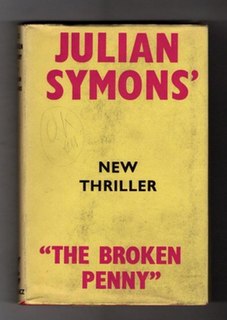
The Broken Penny is a 1953 thriller novel by the British writer Julian Symons set during the early Cold War.

The Man Who Killed Himself is a 1967 comedy crime novel by the British writer Julian Symons.

A Three-Pipe Problem is a 1975 mystery detective novel by the British writer Julian Symons. A pastiche of the original Sherlock Holmes stories by Arthur Conan Doyle, it takes place in the present day. The title refers to a line spoken in The Red-Headed League, referring to a particularly tricky problem that will take Holmes the time it takes to smoke three pipes to solve. It was followed by a sequel The Kentish Manor Murders.

The Kentish Manor Murders is a 1988 mystery detective novel by the British writer Julian Symons. A pastiche of the traditional Sherlock Holmes stories by Arthur Conan Doyle, it is a sequel to the 1975 novel A Three-Pipe Problem.
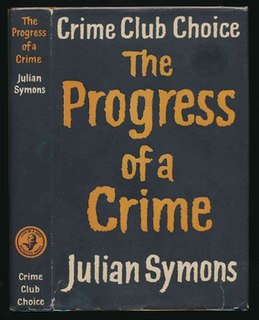
The Progress of a Crime is a 1960 mystery crime novel by the British writer Julian Symons. It was awarded the 1961 Edgar Award.
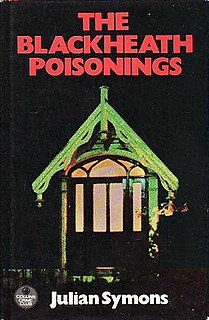
The Blackheath Poisonings is a 1978 historical mystery novel by the British writer Julian Symons. It is a murder mystery set in the late Victorian era.
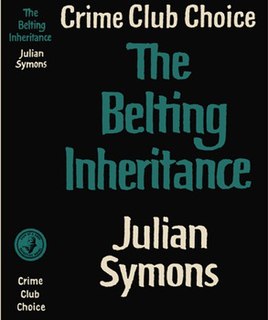
The Belting Inheritance is a 1965 mystery detective novel by the British writer Julian Symons. It is a traditional country house mystery harking back towards the Golden Age of Detective Fiction. It was republished by British Library Publishing in 2018 along with another Symons novel The Colour of Murder.

The Colour of Murder is a 1957 crime novel by the British writer Julian Symons. It was awarded the Gold Dagger of the Crime Writers' Association for that year. It was republished by British Library Publishing in 2018 along with another Symons novel The Belting Inheritance.

The End of Solomon Grundy is a 1964 crime novel by the British writer Julian Symons. The title refers to a line in the nursery rhyme Solomon Grundy.

Sweet Adelaide is a 1980 historical crime novel by the British writer Julian Symons. It is based on the real-life 1886 Pimlico Mystery concerning the possible murder Thomas Bartlett by his wife Adelaide. Symons had already enjoyed success with another Victorian-set mystery The Blackheath Poisonings.
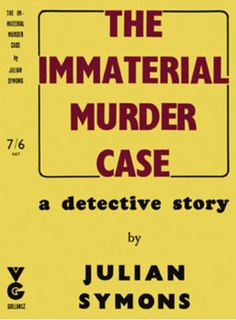
The Immaterial Murder Case is a 1945 mystery detective novel by British writer Julian Symons. His debut novel, it was the first in a trilogy featuring the Scotland Yard detective Chief Inspector Bland. The story gently makes fun of the "Great Detective" archetype popular during the Golden Age of Detective Fiction Symons wrote the book in 1939 but didn't submit it for publication for several years during the Second World War.
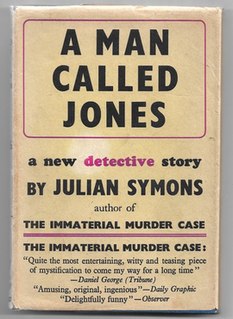
A Man Called Jones is a 1947 mystery detective novel by British writer Julian Symons. It is the second novel in his trilogy featuring the Scotland Yard detective Chief Inspector Bland. Symons was critical of the "Great Detective" that features in so many novels during the Golden Age of Detective Fiction and demonstrates this in the climatic scene where Bland assembles all the suspects to explain his theory, only to first send them to sleep and then be confronted by the late arrival of a previously unknown character on which the whole puzzle hinges.
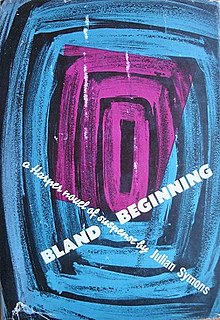
Bland Beginning is a 1949 mystery detective novel by British writer Julian Symons. It is the third and final novel in his trilogy featuring the Scotland Yard detective Chief Inspector Bland. It features Bland before he became a policeman, becoming involved in his first ever case.

The 31st of February is a 1950 mystery crime novel by British writer Julian Symons. It was his fourth published novel following a trilogy featuring Chief Inspector Bland. It further continued the author's toying with the Great Detective type of the classic model during the Golden Age of Detective Fiction. The investigating officer in a potential murder case, Inspector Cresse, is far from flattering portrayed.

The Plot Against Roger Rider is a 1973 mystery thriller novel by the British writer Julian Symons. The novel takes place both in England and Francoist Spain. It was published in the United States by Harper.

Buried for Pleasure is a 1948 detective novel by the British writer Edmund Crispin, the sixth in his series featuring the Oxford professor and amateur detective Gervase Fen. As with the rest of the Fen novels, a complex Golden Age-style mystery is combined with elements of farce. Fen contests a by-election in rural constituency, but events are rapidly overtaken by a murder case. It features Detective Inspector Humbleby who also appeared in the next novel Frequent Hearses as well as most of the short stories in the series.

















